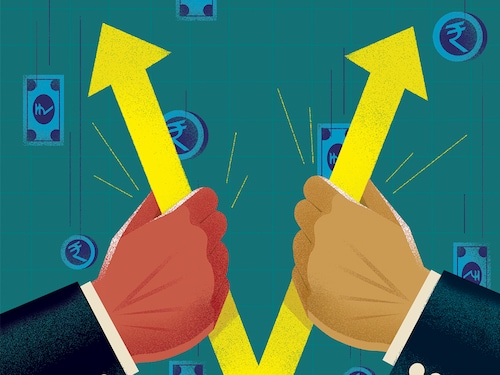Dissecting India's age of duopolies
Swiggy vs Zomato, Ola vs Uber, Amazon vs Flipkart—many of India's hottest sectors have turned into two-horse races. What does this mean for the economy?


 Illustration: Chaitanya Dinesh Surpur[br]It’s an issue as old as consumerism itself—the Coke vs Pepsi, McDonald’s vs Burger King saga. A duopoly—when two firms have dominant control of the market—seems to be the scenario playing out for many of India’s hottest sectors. The newest of these is food tech: As Zomato acquired Uber Eats India in January, the competition now stays between Swiggy and Zomato. What does this mean for India?
Illustration: Chaitanya Dinesh Surpur[br]It’s an issue as old as consumerism itself—the Coke vs Pepsi, McDonald’s vs Burger King saga. A duopoly—when two firms have dominant control of the market—seems to be the scenario playing out for many of India’s hottest sectors. The newest of these is food tech: As Zomato acquired Uber Eats India in January, the competition now stays between Swiggy and Zomato. What does this mean for India?
“Duopoly is not new in this market,” says Harsha Razdan, partner and head, consumer markets and internet business, KPMG in India. “Companies with deep funds are looking to consolidate in a bid to control costs and maintain market share, to expedite shift from penetration to profitability, and achieve cost synergies.”
Uber Eats didn’t have large market share in India, and there were a lot of overlaps for the consumer, so not much has changed on that front. “I don’t think we’ll be seeing monopolies anytime soon,” says Rohan Agrawal, director of management insights firm Redseer. “However, in such scenarios, the role of the regulator becomes more vital, to protect the interests of all stakeholders, not just the shareholders.”
It could cause the government to lose control of parts of the economy. “Two giants control the narrative and essentially play ping pong,” says Abhik Choudhury, chief strategist and founder, Salt and Paper Consulting. “The government needs to be more aggressive in protecting local players, and keep extraordinary checks for corruption, equality dilution.” Choudhury cites the example of China, which hasn’t allowed an Amazon or Walmart to enter, but has created an empire of Alibaba. “We didn’t give ample avenues to the Snapdeals of the world. With 100 percent FDI in retail, no local market can compete with giants like Uniqlo. But if two players dominate that space and in five years, decide to exit India, the entire apparel industry will suddenly collapse, and scores of jobs will be lost.”
It isn’t always a Company A vs Company B scenario either the two could create the illusion of competition, but exchange a quid pro quo in certain segments, so that they can collude on the pricing and the rise of other players. “Amazon and Walmart together can control the ecommerce narrative, while Jabong, Myntra, Snapdeal and Shopclues are sold off for pennies. Coke and PepsiCo did that two decades ago with Limca, Thumbs Up and Mazaa. Facebook and Google with Instagram, WhatsApp and YouTube,” adds Choudhury.
However, especially in the age of break-neck technology developments, no position can be guaranteed in the long term. Unlike past generations, when legacy companies held on to duopolies for decades, a third challenger could well emerge sooner. For instance, for the first time, the Mastercard-Visa debit-card duopoly in India was broken recently, by the government backed RuPay. Debit cards from RuPay doubled to 605.3 million in 2019, from 263 million in 2015, surpassing that of both American giants combined even in 2017, according to GlobalData released in October.
RuPay is, of course, an example that has government funding behind it. “For smaller fish with smart ideas, the giants could either buy you or bankrupt you,” says Choudhury. The eventual goal may be to be acquired by one of the main contenders, but in a dynamic market, it will take more than two and two to consolidate any company’s standing for the long term.
First Published: Jan 30, 2020, 17:15
Subscribe Now